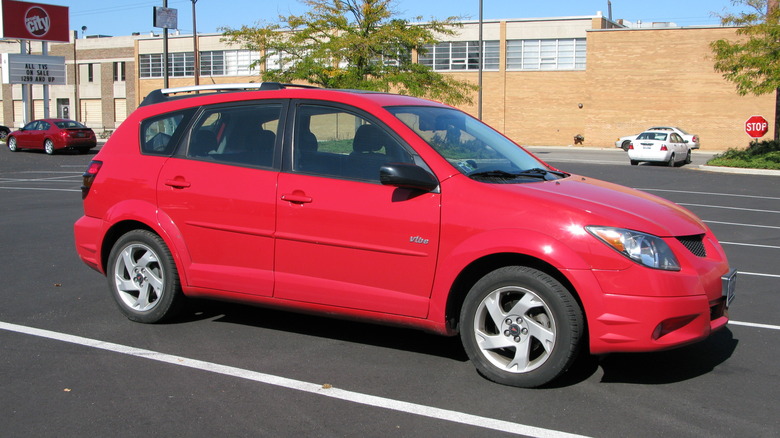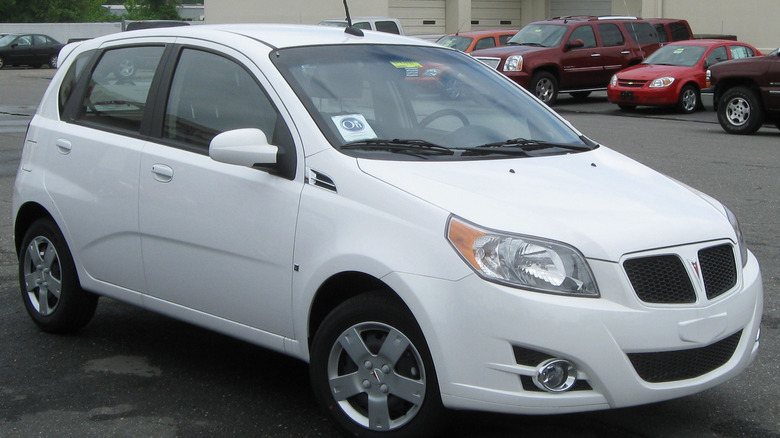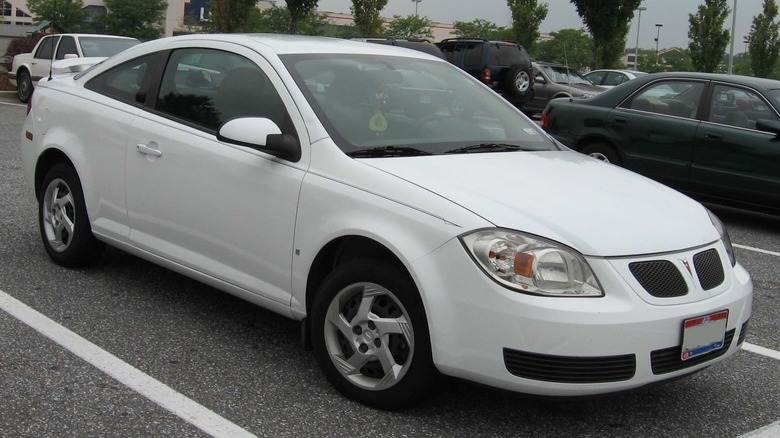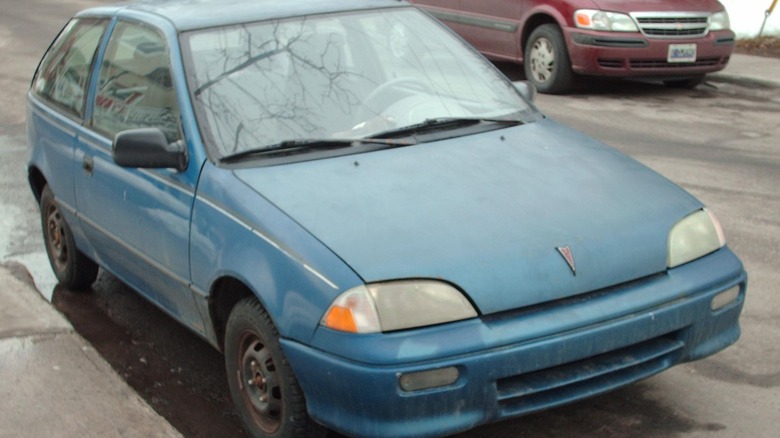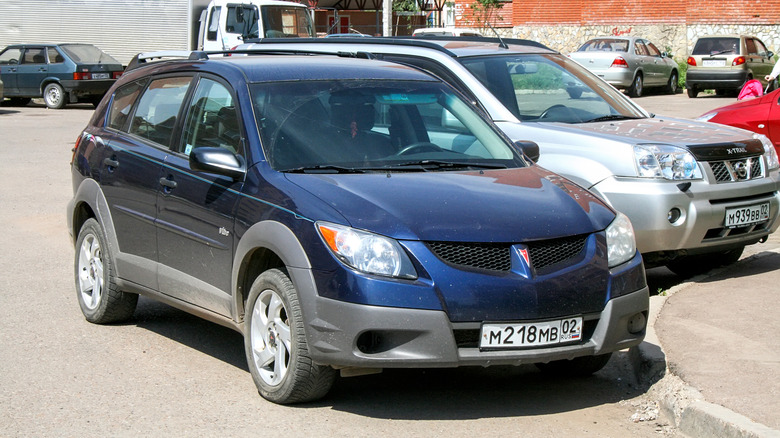Every Pontiac Model That Was Actually Rebadged From A Different Brand
Back in 1907, the Oakland Motor Company was created as the next step in the evolution of what was once a maker of horse-drawn buggies. Oakland was eventually scooped up by General Motors, resulting in the Pontiac brand. The brand got its name after the Pontiac Series 6-27, which was introduced in 1926 as the automaker's first six-cylinder model.
Later in the 60s and 70s, Pontiac became the sporty, more adrenaline-loving sub-brand of General Motors, slotting between Chevy and Oldsmobile in price. Everyone knows and a lot of enthusiasts swear by the likes of the GTO, the Tempest, and the Catalina. And of course, we can't forget about the Firebird, the car that drove Burt Reynolds to stardom in the late '70s. Basically, there are a lot of classic Pontiac we'd want to see come back if the brand ever gets resurrected.
The cars we're covering here weren't quite so memorable. As the years went on, Pontiac slowly became a shadow of its former self, and resorted to periodically rebadging cars — that is, taking a car made by a different company, and slapping the Pontiac brand on it with minimal changes. These weren't necessarily bad cars — you may even see a model you recognize and like — but they weren't the Pontiac originals you might've thought they were at first glance.
Pontiac G3
GM wanted to get super affordable cars into the hands of Americans, but in the 2000s, it hadn't developed its own super affordable car platform. So the company decided to bring in cars from its Korean arm, Daewoo, and badged them as Chevrolets.
One of the most notable examples of the GM Korea imports was the Aveo, a subcompact hatchback that wasn't exactly most people's idea of a good or interesting car. It was cheap, slow, badly made, and had almost no charisma whatsoever. In the late 2000s, in order to save a dying Pontiac, GM repurposed the Aveo, gave it some slight styling updates, and badged it as the Pontiac G3.
Other than the very slightly different exterior design, the Aveo (which was later succeeded by the Sonic) and G3 were basically identical. To add insult to injury, the G3 was the last ever Pontiac model to be introduced before the automaker went bankrupt. This has to be one of the saddest ends for such a well-loved automotive brand, to go from muscle cars to thinly disguised Korean hatchbacks, just to squeeze a few more sales in.
Pontiac G5
Another car in the very diverse G series, the G5 may look pretty familiar on first glance, and there's a reason for that. Other than the badging and the front grille, the G5 was in all other aspects a Chevrolet Cobalt. The Cobalt was a fairly normal compact car that Chevy offered in North America throughout the 2000s, but the Pontiac G5 was the name given to the model in the Canadian market specifically.
If that wasn't confusing enough, GM also sold the Chevy Cobalt in Mexico where it was known as... the Pontiac G4. The G5 slotted below the Vibe (we'll get to that one as well), and it was nothing more than a three-door version of the Cobalt.
One cool thing about the G5 is that Canadian buyers got the option of a diet Cobalt SS. Called the G5 GT, it was offered with a 2.4-liter naturally aspriated inline-four Ecotec engine putting out a respectable 173 hp, essentially the same unit that you'd find in the Pontiac Solstice. While there was no supercharger or turbo, the styling was basically the same, including that iconic rear wing. The G5 is just one of many, many, many random vehicles that GM sold in Canada as a Pontiac. As we will soon discover...
Pontiac Firefly
When it comes to cars that enthusiasts love to make fun of, the Geo Metro is a hall-of-famer, right up there with the Toyota Prius and the Yugo. The Geo Metro came to North America in the 1990s as a way for GM to offer a super affordable car to the masses and repair its patchy reliability reputation.
That's because under the Geo branding, the Metro was essentially a '90s Suzuki Swift. The Suzuki Swift had great fuel economy and reliability in spades, but other than that, it had little to offer besides basic A-B transportation. And a convertible variant, because that's what everyone wanted.
While the Geo Metro served its purpose for a lot of mass market buyers, it's still a widely mocked car even today. Canada was also lucky enough to get its own rebadged Suzuki Swift, but GM decided to skip the Geo brand, opting instead to badge it as the Pontiac Firefly. Despite the nomenclature and badging, the two really are basically the same. Yes, the Firefly came as a convertible, too.
Pontiac Acadian
This one is just straight up bizarre. The Acadian brand was another Canada exclusive, serving as the successor to the Beaumont brand. Initially, the Acadian brand was created to allow dealers in Canada to offer a compact car to customers, that car initially being the Chevy Nova. One of the most beloved compact muscle cars of the 60s and 70s became an Acadian in Canada, but other than that, it was mostly the same. The Beaumont brand would also go on to appear on imported Chevy Chevelles in Canada.
GM would revisit the Acadian brand in the 1970s for something entirely unrelated and different. By that point, the Acadian models based on the Chevy Chevelle and Nova had both been long discontinued, but GM brought back Acadian as a model name for a slightly reworked version of the Chevrolet Chevette compact. The Chevy badge was also replaced by a Pontiac one.Then things got even more complicated.
The United States market was introduced to a separate Pontiac-badged Chevette, the T-1000. The styling differences would then make an appearance on the updated Acadian in the late 70s, making for one very confusing badge engineering job.
Pontiac G2
This was one of Eastern Europe's favorite cars some 20 years ago, but not necessarily because it was good. The Daewoo Matiz was a huge success in developing markets like Eastern Europe for one major reason: it was really, really cheap. However, cheap doesn't always mean cheerful. It featured a gutless three-cylinder engines, some bits of gray plastic that felt strewn together in the shape of an interior, and style by people must have been really into bad cyberpunk anime.
The Matiz would reach other markets all over the world, where it was known under a dozen different names. Yes, GM really did decide to stain the Pontiac name by putting it on the Matiz, creating the Pontiac G2. The company only marketed the Matiz under this name in Mexico, though later versions became known as the Pontiac Matiz.
Pontiac badge or not, in the case of the Matiz, you're much better off buying any other car... or even using public transport.
Pontiac Sunburst
Before Isuzu focused basically all of its efforts on commercial vehicles, it made some pretty interesting passenger vehicles, like the eccentric cult classic VehiCROSS SUV. However, when Isuzu became a part of General Motors after the latter bought a pretty large stake in the early '70s, the acquisition led to, you guessed it, more badge engineering!
Pontiac got yet another badge engineered compact car to offer to Canadians, this time bearing the name Sunburst. The car was essentially just an Isuzu Gemini — same powertrain, same general styling. And then it got even more convoluted.
GM would eventually change course and swap out the Pontiac badge for a Chevy badge, and then a Geo badge, deciding that the Gemini was a better fit with the ethos of that brand. With Chevy and Geo badges, the Gemini became the Spectrum, which was sold Stateside. Confusingly, Isuzu also sold the Gemini in the U.S. during this time, under the name I-Mark.
Pontiac Sunrunner
Not only is it another example of GM Canada badge engineering, it's another example of a captive import that adopted the Pontiac name in Canada. It's also a testament to how much Pontiac loved the "sun" prefix. The Sunrunner was a small SUV that might look familiar to some. That's because it's based on the Suzuki Vitara.
The Suzuki Vitara came to the United States as another Geo-branded import called the Tracker. The Tracker is the second best-known Geo model alongside the Metro, and despite the difference in badging, the Tracker is a Vitara through and through. Similarly to the Metro, the Tracker has also gone on to gain a cult following among certain car enthusiasts, who still enjoy driving and off-roading their Trackers to this day.
That's not a bad thing, as the Vitara was known to embarrass much bigger, purpose-built off-roaders at a fraction of the size and cost. It was much the same with the Sunrunner, but good luck finding one in the wild today.
Pontiac Tempest
Here's a Pontiac vehicle that we've all forgotten about. While it uses the name of one of the most iconic Pontiac models of all time, the second iteration of the Tempest is nothing at all like the original. The original is best known for forming the basis of the Pontiac GTO, one of the most iconic American muscle cars — it lasted almost a decade, from 1961 to 1970, after which Pontiac retired the name.
But then, the Tempest made a resurgence in 1987. You may be thinking this was the perfect opportunity for another performance model to introduce a new generation to the iconic Tempest, but no, it' was another foreign market special. Despite the Pontiac branding, the revived Tempest was a thinly disguised Chevy Corsica.
Eventually, Pontiac would realize the error of its ways, and this would be the last time we ever saw the Tempest name on anything with a Pontiac badge.
Pontiac Vibe
Finally, a different kind of badge engineering. GM was livid that the Japanese were leading the market in the 90s and the 2000s, which ultimately led to the GM and Toyota merger. The joint GM-Toyota factory based in Fremont, California was called NUMMI. Sadly, the Pontiac Vibe was the only product to come out of the merger, and the only vehicle from this partnership that was assembled at the now Tesla-owned facility. After only a few years on the market, the Vibe was discontinued.
Despite the unique styling, the Vibe was based on the Toyota Matrix hatchback, and they shared pretty much every component. Pontiac also offered a hot version of the Vibe called the GT, which used a high-revving 1.8-liter inline-four, also known as the 2ZZ-FE, similar to what you might find in the Toyota MR2 and the Lotus Elise.
It was also offered with a six-speed manual transmission and AWD. In some ways, the Vibe is a Geo for the 21st century. Japanese hardware with American badging and some sheetmetal. Although the Vibe wasn't a massive success, it still has a dedicated cult following even to this day.
